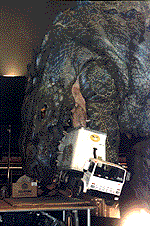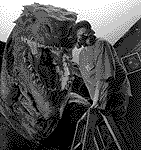Spotlight : August 1998
Spotlight : August 1998
 Tatopoulos directs Big-G on the greenscreen stage. |
Two suits were on hand for each performer, to account for wear and tear; some minor facial damage occurred when the babies broke through the eggs. Though the Godzilla shop designed and sculpted the eggs, KNB EFX Group made the molds, producing three hero eggs, each made out of thick fiberglass with a very thin fiberglass plug under a membrane through which the babies' heads burst. CGI babies were added for the full-motion creatures running behind the actors in the background. "The CGI babies were executed at the end of the schedule, and by then I was working on other projects," Tatopoulos remarked. "My primary job with the CG work in the show was to make sure that they had the exact Godzilla in the computer that we had in our shop."
While the babies were shooting, Tatopoulos' team was actively developing the 1/24-scale Godzilla suit and the 1/6-scale mechanical Godzilla, with sculpting supervision by Jose Fernandez. First, the 1/24-scale suit was created in clay, with a smaller version used for CG scanning fashioned by Tom Floutz. "Every technique that was used for the baby suits was duplicated for the Godzilla suit," Tatopoulos conveyed. "We had a less bulky suit - lighter and tighter to the body. The challenge was that we needed more movement and complete confidence in the performance. Also, the limitations of the suit were more obvious because we couldn't make it match the CGI character running full speed in the street." Final shots of the Godzilla suit in the film included the character bursting through the street in front of Matthew Broderick, attacking a helicopter, and turning around a building corner, all on a miniature New York set. "We shot lots of stuff with the suit that wasn't used, including the
 The 1/6 scale Godzilla animatronic gobbles up a miniature truck for one of its early New York appearances. |
In addition to the Godzilla suit work shot on set, Tatopoulos directed the character's motion-capture material, facilitated by performers in spandex suits covered with computer-sensitive capture points. For six weeks, Tatopoulos choreographed scenes of baby-zilla actors Kurt Carley and Bruce Marrs in the suits, trying to translate their movements into working computer animation. "The creature design had human features, so some of Godzilla's articulations were supposed to be humanoid," commented Tatopoulos. "We definitely didn't want him to use his hands except for pushing his body up and down, so any attacking motions would be achieved with his mouth." However, Emmerich felt that the result looked more like a man in a suit and less like an animal, so only a few shots of it were used in the finished film. "Motion capture is a great previsualization tool to key-frame animation, which was the final technique used in GODZILLA," he observed. "I believe motion capture could have done the job. Ultimately, it is a director's choice, and Roland went for key-frame."
The final practical Godzilla element on Tatopoulos' schedule was the 1/6-scale completely-mechanical creature. To design its mechanics, months before it was actually sculpted, the 1/24-scale suit was surveyed and scaled up by Himber's team. "Doing so provided an understructure that had key points on it, to indicate jaw and eye placement, for example." Himber described. "That way, the sculptors could incorporate their designs around it, so we knew the creature's skin and mechanics would all fit together later." The 1/6-scale Godzilla was sculpted out of gold foam: it registered 30 feet from its nose to back, 16 feet from the top of its head down to the middle of the chest, and 25 feet across from pinky to pinky. Jim Leonard and Russell Seifert supervised a night crew that created the enormous 1/6-scale apoxy molds like a patchwork quilt. "After two weeks of making molds section by section," Jake Garber remembered, "the
 A Tatopoulos crewmember puts the finishing touches on the 1/6 scale Godzilla. |
After nine months of production time, the 1/6-scale Godzilla was finally
filmed in a massive former aircraft facility near the Los Angeles airport. Engineers came to examine the floor of the building and make sure that it was solid enough to hold up the creature, which weighed 12,000 to 14,000 pounds, including the hydraulic Godzilla, frame, and counterweight system. Tatopoulos rented a motion base, similar to ones used for flight simulators, and locked it on the huge stage; miniature buildings were then built around the structure. "The motion base allowed Godzilla to have smooth lateral movements, and we attached the fully-hydraulic creature on top of it," explained Tatopoulos. Bob Gurr designed a steel frame for the creature's upper torso, arms, and head - assembled and built by Donald Anderson - and Dave Kindlon was responsible for the design of the head and its features. The skin that went over the frame was created out of traditional foam latex which Tatopoulos felt was still the best material to create a believable reptilian look. Jake Garber fondly recalled maintaining the beast on set: "Gino Acevedo, Gabe Bartalos and I constantly touched up the 1/6-scale Godzilla, adding dirt, blood, or sweat to the head - we were its makeup artists!"
Back to the Spotlight Main Menu

. . VFX HQ Produced by Todd Vaziri . . http://www.vfxhq.com . . e-mail: tvaziri@gmail.com . .
All text Copyright © 1998 Todd Vaziri, unless otherwise noted